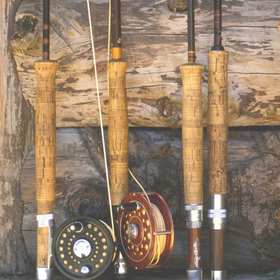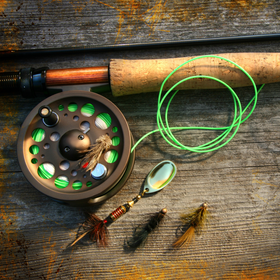To Shop Caddis Flies Click Here
Next to a amiable fishing partner, and perhaps a trusted fly rod, Caddis flies or Sedge flies may be the trout fly fishers best friends. Much ado is made about specific mayfly hatches, and the frenzied activity they cause is anticipated by fish and fly fisher alike. But a nice long prolific, steady caddis hatch gives one the opportunity to fish whenever the schedule allows. Most fly fishers recognize an adult caddis fly or imago, yet compared to favorite mayflies they may relatively in the dark about caddis.
 - Adult caddis. Notice the "tent wing"
- Adult caddis. Notice the "tent wing"
Large adult caddis are often mistaken for salmonflies. There is one simple way to tell the difference: Caddis flies have a tri-fold wing, that is tented when the fly is at rest, while a salmonfly's wings lay flat along it's back.
 - Caddis are mistaken for Salmonflies occasionally.
- Caddis are mistaken for Salmonflies occasionally.
Caddis are present throughout the world, and are represented by some 7,000-12,000 different species, depending on who you believe. Their sheer numbers undoubtedly make it harder to wrap your brain around. Six to a dozen major mayfly hatches are much easier to remember.
All Caddis flies begin life in larvae form. The case building caddis is the most famous, and in many places the most common. These case making larva build their 'shell', from available silt and other sediment, commonly called periwinkles, they have long been used as bait where allowed. The largest of these is found in the Northwestern US and Canada and eventually hatch into the October Caddis. There are also net building caddis that trap food like a spider, these larva are stationary and therefore not as important to the fisherman.
 - A caddis larva is a great snack for a hungry trout.
- A caddis larva is a great snack for a hungry trout.
In the larva stage caddis or voracious eaters, and especially free living caddis often creep into water too fast for their own good. This recklessness is of major benefit to trout, and trout fishermen. Fishing seams of faster water with a good sunken caddis pattern will often result in some aggressive strikes.
Unlike mayflies, caddis enter a pupal stage, where they attach their cases to an rock or sunken log and seal themselves inside. Non-structure building caddis actually spin a cocoon like a butterfly. This stage lasts not very long, and while they are inactive they are not of vast importance to trout.But the emergence is an entirely different story, although it is even shorter lived, it is the source of frenzied activity. Pupas emerge usually by biting through their casing or cocoon. Some actually swim to shore and crawl out of the water ala salmonflies, but the majority swim to the surface, usually with the aid of air bubbles from inside their cocoon. Shedding skin, gills, casings, mandibles, all now unnecessary appendages there is nothing subtle about their emergence. And the trout now gorge!
 - Cased caddis can exist underwater in huge numbers on logs and rocks
- Cased caddis can exist underwater in huge numbers on logs and rocks
Adult caddis live one to two weeks. They really have only one job, reproduction. Egg laying occurs usually at night but not necessarily. Many summer evenings can be filled with caddis flying into wading fisherman. Eggs are laid in one of two ways; either by depositing them from above, or actually swimming into the water. This last one makes them increasingly vulnerable to trout.




